JERUSALEM: The growth of Israel’s West Bank settler population accelerated last year, according to figures released by a pro-settler group on Thursday, despite renewed American pressure to rein in construction on occupied territory that the Palestinians want for a future state.
The figures show that a settlement surge initiated when President Donald Trump was in office shows no sign of slowing down.
Trump provided unprecedented support for Israel’s claims to land seized in war, reversing decades of US policy.
President Joe Biden’s administration has returned to the previous approach, criticizing settlement expansion as an obstacle to resolving the conflict. But Israel has continued to build and expand settlements, and major road projects are expected to bring even more settlers into the territory.
The statistics, compiled by WestBankJewishPopulationStats.com and based on official figures, show the settler population grew to 490,493 as of Jan. 30, a nearly 3.2 percent rise over 13 months. The population has risen by 16.5 percent since the group began compiling statistics in 2017, it says.
Israel’s overall annual growth rate, by comparison, is around 1.7 percent. In 2020, the last year of the Trump administration, which also saw repeated coronavirus lockdowns, the settler population in the West Bank grew by 2.6 percent, according to the group.
“There’s a tremendous amount of construction going on,” said its CEO, Baruch Gordon, including in his community of Beit El, just outside the West Bank city of Ramallah, where the Palestinian Authority is headquartered.
“Right now there’s 350 units going up that will probably be finished within a year, year and a half. So when that hits, that’s going to increase the size of our town by about 25 percent,” he said.
The settler population tends to be younger and more religious, with a higher average birth rate. Many Israelis are drawn to the state-subsidized settlements for the quality of life.
They resemble suburbs or small towns and offer lower housing prices than Israel’s crowded and increasingly unaffordable cities. The pandemic might have made the settlements even more attractive.
“Just like in America, people moved out of Manhattan and went to suburbs and found that they could live in more open spaces, and the same is happening in Israel,” Gordon said.
His figures do not include East Jerusalem, which Israel annexed in a move not recognized internationally, and which is now home to more than 200,000 Jewish settlers. The West Bank and East Jerusalem are together home to some 3 million Palestinians.
Israel captured both territories, along with Gaza, in the 1967 Mideast war.
The Palestinians view the growth of settlements as the main obstacle to peace because they cut off Palestinian communities from their land and from one another, and make it nearly impossible to create a viable state. Settlements have expanded under every Israeli government, even at the height of the peace process in the 1990s.
There have been no serious peace negotiations in over a decade, and Israel’s current prime minister, Naftali Bennett, is a former settler leader opposed to Palestinian statehood.
Israel’s political system is dominated by pro-settler parties that view the West Bank as the biblical and historical heartland of the Jewish people.
The international community still considers a two-state solution to be the only realistic way of resolving the century-old conflict, but it has provided no incentive for Israel to end the occupation — now well into its sixth decade.






















